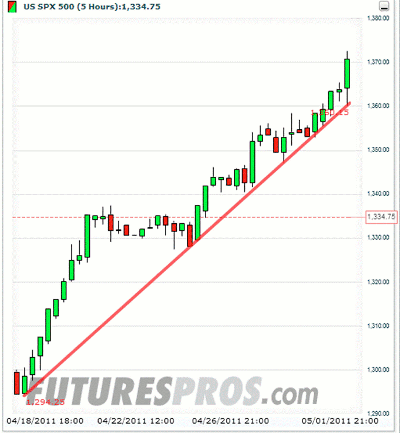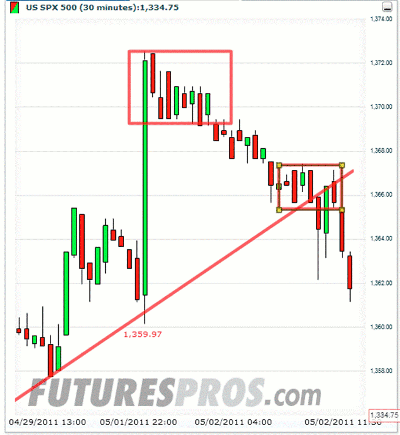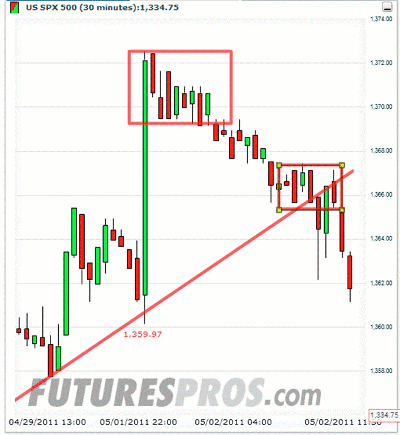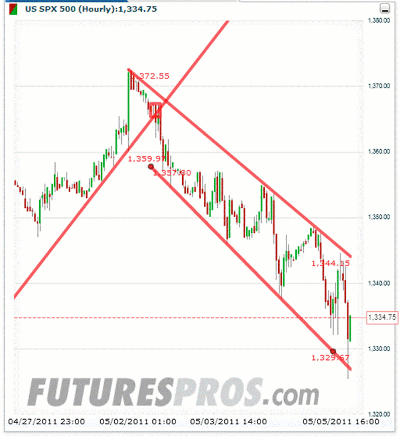Focusing too much on short-term trends and not the bigger picture cost this trader a huge profit on the S&P rollercoaster last week.
Upon reviewing my trades so far this month, I quickly realized that, although I was reasonably profitable for the week, I did not manage several trades up to the standard to which I try to hold myself.
The common flaw of the aforementioned trades was an over-eagerness to lock in profits despite overwhelming evidence that I was correctly positioned to realize further profits. It would take too long to go into extended details of all the trades in question. Instead, I will focus on one trade in particular, which I believe may have been the best risk-adjusted set-up of the week.
Hindsight is 20-20, particularly when it comes to the markets. However, allow me to set the scene to help illustrate just how powerful this set-up was on a risk-adjusted basis.
On the evening of Sunday, May 1, the S&P futures rallied above 1,372 after news of Osama bin Laden’s death at the hands of US special forces began to circulate through cyberspace. Less than two weeks earlier, the S&P futures had traded as low as 1,290, after Standard & Poor’s placed the sovereign debt of the United States on a negative outlook.
It is easy for market participants to get swept into the euphoria of a major news announcement such as the bin Laden news. Sunday night’s 13-point S&P spike on the bin Laden news was no different—my Twitter/StockTwits streams gave me all the evidence that I needed to prove euphoria was in the air. Therefore, despite my intermediate/long-term view on equities, my market instincts told me that fading this “bin Laden spike” was the right short-term move. Let’s have a look at the chart:
At 11:15 pm, with the S&P 500 at 1,372 in anticipation of President Obama’s press conference, I had a powerful urge to begin scaling into a short $ES_F (E-mini S&P futures) position.
Given that I would be attempting to get some sleep in the next couple of hours, initiating a new and potentially volatile trading position wasn’t exactly a great idea. My better judgment took over, and I decided to wait until the morning when I would be more focused and have more information (reference points, etc.) with which to work.
|pagebreak|The S&P oscillated within a tight range (1,369-1,371) for several hours before breaking under 1,370 and grinding lower into the US open. By 9:30, when the markets opened, some important reference points had been established:
- The overnight high of 1,372.55
- The prior support level of 1,369-1,370
- The morning high of 1,367.45
The above reference points allowed one to initiate a short position with clearly defined risk using any or all of the reference points. In combination with an 80-plus-point S&P rally in just two weeks and an overbought market condition, the stage was set for an excellent risk/reward shorting opportunity.
Immediately after the market open, I began hedging some of my long equity exposure by buying put options on Russell 2000 iShares (IWM) and entering into bear call spread positions on individual names such as Agrium (AGU) and Mosaic (MOS).
By 10:00, my attention turned to entering into a short $ES_F position that I would attempt to manage entirely separate from my other positions. I shorted $ES_F at 1,365.75 and immediately set a buy/cover stop at 1,368.25; the risk was 2.5 points or $125 per $ES_F contract. I chose the stop price because it was slightly above the morning high of 1,367.45, and allowed some “room for noise.”
My initial target was the overnight lows/gap fill area around 1,360, making the trade roughly a 1:2 risk-to-reward set-up. You can see that this target was achieved less than two hours later.
Instead of covering half or 75% of the position and establishing a core swing trading position, I covered the entire position once the gap was filled and my short-term target was achieved. By getting too caught up in the short-term market movements, I lost perspective of the bigger picture—and the potential for a much larger profit.
For example, let’s say I had shorted four ES_F contracts at 1,365.75 and covered three at 1,360.25 for +5.50 points. I could have then set a stop at break-even on the final contract and used a trailing stop on that final contract every 4 to 5 points lower.
By allowing myself to become too focused on the short-term (as clouded by my bullish medium/longer-term view), I prevented myself from having a 20-plus-point swing trade in ES_F.
This week I will refocus on trading less—quality, not quantity—and remembering to keep the bigger picture in mind.
Robert Sinn is a trader and blogger at RobertSinn.com.
By Robert Sinn

























